IMPORTANT POINTS
The human is unisexual and viviparous. Reproduction is the mechanism by which continuation of generation is sustained. like all other vertebrates human also exhibits sexual dimorphism.The male and Female reproductive systems are organized by several types of organs.The organs of the male reproductive system are one pair of testes, one pair of epididymis, one pair of vas deferens, one pair of seminal vesicles prostate gland bulbourethral gland, urethra and penis. Female reproductive system consists of one pair of ovaries, the uterine tubes, uterus vagina, external genitalia and mammary glands.
To produce gametes ,gametogensis occurs in both male and female.The male gamete is known as sperm and female gamete is known as ovum.The process of sperm production is known as spermatogenesis and ovum production is known as oogenesis.
Menstrual cycle is the events of the cyclic changes in the endometrium, which it goes through month after month as it responds to changes in the levels of female sex hormones in the blood.
The one sperm and one ovum become involved in fertilization.A diploid zygote nucleus is formed through the fusion of male and female pronucleus.Now fertilized ovum is called zygote. During movement of zygote in to oviduct cleavage occurs.The embryo with 16 cells is called morula. Now the process of implantation of embryo take place The period of development of young one in female reproductive system is known as pregnancy. It takes approximately 266 to 280 days. The process of child birth is called parturition. The mammary glands of the mother under go differentiation during pregnancy and start producing milk after delivery this process is called lactation.
1. Which of the following character is seen in female ?
(a) Muscles arestrong
(b) Mammary gland is well developed
(c) Voice is heavy
(d) Mammary gland is namesake only
2. Which of the following character is seen in male?
(a) Muscles are comparitively weak
(b) Voice is shrill
(c) Voice is heavy
(d) Beard and mustache is not seen
3. Where testes are situated?
(a) Abdominal cavity
(b) Dorsalside of abdominal cavity
(c) (a) and (b) both
(d) Scrotal sac.
4. Which hormone is released from testes ?
(a) Testosterone
(b) Estrogen
(c) Progesterone
(d) Relaxin
5. Which hormone is realeased from ovaries ?
(a) Testosterone
(b) Estrogen
(c) Progesterone
(d) (b)and(c)both
6. Which of the following gland is seen in male reproductive system ?
(a) Seminal vesicle
(b) Prostate gland
(c) Bulbourethral gland
(d) All of these
7. How much lower the temperature of scrotal sac as compare to the normal body temperature ?
(a) 3oc
(b) 4oc
(c) 5oc
(d) 6oc
8. What is the size of testis?
(a) 6 cm length and 2.5 cm diameter
(b) 5 cm length and 2.5 cm diameter
(c) 5 cm length and 3.5 cm diameter
(d) 6 cm length and 3.5 cm diameter
9. Which connective tissue surrounds testis ?
(a) Fibrous tissue
(b) Spongy connective tissue
(c) Tunica albuginea
(d) None of them
10. Seminiferous tubule in testis are lined with Which type of cells ?
(a) Germinal cells
(b) only germinal cells
(c) Sertoli cell
(d) Both a and c
11. In testis which cells produce sperms?
(a) Germinal cells
(b) Epithelial cell
(c) Sertoli cell
(d) Both a and c
12. Which cells provides nutrition to the sperms ?
(a) Germinal cells
(b) Epithelial cell
(c) Sertoli cell
(d) None of them
13. In testis which cells are present in the interstitial space between seminiferous tubules?
(a) Sertoli cells
(b) Germinal cells
(c) Leydigs cells
(d) (a)and(b)both
14. Which cells secretes testosterone ?
(a) Sertoli cells
(b) Germinal cells
(c) Interstitial cells
(d) (a)and(b)both
15. Where seminiferous tubules of each lobe empty sperms ?
(a) Vas deference
(b) Vasa efferentia
(c) Epididymus
(d) Seminal vesicles
16. Where is situated epididymis ?
(a) External surface of the testis
(b) Above the testis
(c) Below the testis
(d) Internal surface of the testis
17. What is length of epididymis?
(a) 6 c.m
(b) 6 feet
(c) 6 meter
(d) 6 inch
18. Function of epididymis is____
(a) A temporary storagesite
(b) For the immature sperms complete their maturation process
(c) Gain the ability of swimming (motility)
(d) All of these
19. When sperms are transported in to vas deference from epididymis ?
(a) Male is not sexually stimulated
(b) Male is sexually stimulated
(c) The walls of the epididymis contract
(d) First -b and after -c process occurs
20. What is length of vas deference ?
(a) 45 inch
(b) 45 mm
(c) 45 cm
(d) 4.5 meter
21. Through which of the following vas deferens runs upward from epididmis and enter the abdominal cavity ?
(a) Ejaculatory duct
(b) Inguinal canal
(c) Urethra
(d) (a)and(b)both
22. The distal end of vas deference is expanded and in this region the opens ?
(a) Prostate gland
(b) Bulbourethral gland
(c) Seminal vesicle
(d) Ejaculatory duct
23. What is the region present between part of seminal vesicle and duct of urinary bladder called ?
(a) Ejaculatory duct
(b) Duct of urinary
(c) Urethra
(d) Seminal vesicle duct
24. Duct of which gland join with urethra before it passed through penis ?
(a) Prostate gland
(b) Bulbourethral gland
(c) Seminal vesicle gland
(d) (a) and (b) both
25. In male accessory reproductive glands which is incorrect ?
(a) Seminal vesicle
(b) Prostate gland
(c) Urinary bladder
(d) Bulbourethral gland
26. The seminal vesicle are located at ?
(a) Over urinary bladder
(b) Base of the urinary bladder
(c) Near urinary bladder
(d) Besides urinary bladder
27. What percentage of semen is produced by seminal vesicles ?
(a) 50%
(b) 55%
(c) 60%
(d) 65%
28. Which substances present in seminal vesicles is thick and yellowish secretion ?
(a) Sugar
(b) Vitamin-c
(c) Fat
(d) (a)and(b)both
29. What is provided to sperms by secretion of seminal vesicles ?
(a) Nourishment
(b) Activating
(c) Lubricant
(d) (a)and(c)both
30. Where is prostate gland is located ?
(a) Over urinary bladder
(b) Base of the urinary bladder
(c) Posterior region of the urinary
(d) Side of the urinary bladder
31. What is provided to sperm by secretion of prostate gland ?
(a) Nourishes
(b) Activating
(c) Lubricant
(d) (a)and (c) both
32. Where is bulbourethral gland located ?
(a) Beneath the prostate
(b) Lateral side of urethra
(c) Over urinary bladder
(d) (a) and (b) both
33. Which gland secrete alkaline fluid ?
(a) Seminal vesicle gland
(b) Prostate gland
(c) Bulbourethral gland
(d) (b) and (c) both
34. What is the function of bulbourethral gland secretion ?
(a) Nourishes sperms
(b) role in activating sperms
(c) Serves as a lubricant during sexual intercourse
(d) Enhancing the motility of sperms
35. Mixture of which of the following constitute semen ? OR
(a) Sperms
(b) Secretion of accessory glands
(c) Organic substance
(d) Both a and b
36. What is PH of semen ?
(a) 7.3 to 7.7
(b) 7.2 to 7.6
(c) 7.4 to 7.8
(d) 7.5 to 7.9
37. What is PH of vaginal fluid ?
(a) 3.5 to 4.0
(b) 3.6 to 4.1
(c) 3.7 to 4.2
(d) 3.8 to 4.3
38. The average volume of semen for each ejaculation is _____
(a) 3 to 4 ml
(b) 3.5 to 4.5 ml
(c) 4 to 5 ml
(d) 4.5 to 5.5 ml
39. Which cylindrical organ is located at frontal region of scrotal sacs ?
(a) Epididymus
(b) Vas deference
(c) Penis
(d) (a) and (b) both
40. Internally the penis is______
(a) Composed of three cylindrical mass of conective tissue bound together
(b) Composed of three cylindrical mass of tissue bound together by fibrus tissue
(c) Composed of three cylindrical mass of epithelium tissue bound together
(d) Composed of three mass of tissue only
41. When does penis get erected ?
(a) If masses of tissue filled with air
(b) If masses of tissue filled with blood
(c) If masses of tissue filled with hormones
(d) (b) and (c) occurs both
42. Which is accessory part of female reproductive system ?
(a) Vulva
(b) Pudendum
(c) Mammary gland
(d) Vagina
43. What is size of ovaries ?
(a) 3 c.m long , 2 c.m wide , 1 c.m thick
(b) 2 c.m long , 2 c.m wide , 1 c.m thick
(c) 3 c.m long , 2 c.m wide , 2 c.m thick
(d) 2 c.m long , 2 c.m wide , 2 c.m thick
44. Where are ovaries situated ?
(a) In upper pelvic cavity
(b) Below pelvic cavity
(c) At one on each side of uterus
(d) (a) and (c) both
45. The ovaries maintain their position by_____
(a) Series of ligaments
(b) Connective leyer
(c) Epithelium layer
(d) Muscular filament
46. What is the entry point for blood vessel and nerves into the ovaries called ?
(a) Hilus part
(b) Hilus
(c) Hilus pors
(d) None of them
47. Which tissue layer covers the ovary ?
(a) Columnar epithelium
(b) Squamous epithelium
(c) Cuboidal epithelium
(d) Ciliary epithelium
48. What is the surrounding layer of the ovary called ?
(a) Germinal epithelium
(b) Tunica albuginea
(c) Stroma
(d) Collagenovs
49. What is called a capsule of collagenous connective tissue immediately after the germinal epithelium of ovaries?
(a) Stroma
(b) Tunica albuginea
(c) Ovarian epithelium
(d)None of them
50. Which tissue layer of tunica albuginea
(a) Connective tissue
(b) Collagenous connective tissue
(c) Epithelial tissue
(d) Collagenous epithelium tissue
51. What is called a region of connective tissue deep to the tunica albuginea ?
(a) Stroma
(b) Follicular epithelium
(c) Graffian follicles
(d) Corpus luteum
52. Ovarian stroma is composed by_____?
(a) Cortex
(b) Medulla
(c) Follicles
(d) (a) and (b) both
53. Stroma of ovarian cortex contains_____
(a) Ovarian follicles
(b) Corpus luteum
(c) Graffian follicles
(d) (a) and (c) both
54. What is the structure consist of ova and their surrounding tissues in various stages of development its called ?
(a) Primary follicle
(b) Ovarian follicles
(c) Graffian follicles
(d) Corpus luteum
55. What is the structure consist of mature ovum and its surrounding tissues its called ?
(a) Mature ovum
(b) Ovarian follicles
(c) Graffian follicle
(d) Corpus luteum
56. Graffian follicle after ovulation produces glandular body, it is called____.
(a) Graffian follicle
(b) Corpus luteum
(c) Mass of graffion follicle
(d) both a and b
57. Which hormones is produced by corpus luteum ?
(a) Estrogen
(b) Progesterone
(c) Testosterone
(d) (a) and (b) both
58. What is length of fallopion tube ?
(a) 10 c.m
(b) 10 m.m
(c) 12 c.m
(d) 12 m.m
59. The uterine tube from side runs forwards and becomes associated with it ____
(a) Vagina
(b) Uterus
(c) Urethra
(d) Ovary
60. Where an ovum is fertilization occors ?
(a) Vagina
(b) Uterus
(c) Fallopion tube
(d) Infundibullum
61. Where is uterus situated ?
(a) Between the urinary bladder and rectum
(b) Between the urinary bladder and urethra
(c) Between the urinary bladder and ovary
(d) Between the urinary bladder and intestine
62. What is the shaped of uterus ?
(a) Inverted appleshaped
(b) Inverted pear shaped
(c) Inverted mango shaped
(d) None of this
63. The wall of the uterus is made of_____layer .
(a) Three
(b) Two
(c) one
(d) Four
64. In which layer of uterus the fertilized egg is implanted ?
(a) Endometrium
(b) Myometrium
(c) Epimetrium
(d) None of this
65. It is a bulky middle layer of the uterus and its plays an active role during the delivery of a baby__
(a) Endometrium
(b) Myometrium
(c) Epimetrium
(d) None of this
66. The distal narrow end of the uterus is called___
(a) Vagina
(b) Cervix
(c) Hymen
(d) (a) and (c) both
67. Which part is connected to the uterus through cervix ?
(a) Vagina
(b) Hymen
(c) Mucosal membrane
(d) (a) and (c) both
68. It is a fold at the distal end of the vagina____
(a) Hymen
(b) Mucosal membrane
(c) Cervix
(d) Clitoris
69. What is called cushion of fatty tissue in female external genitalia ?
(a) Mons pubis
(b) Labia majora
(c) Labia minora
(d) Clitoris
70. Which region of vulva are located below the mons pubis ?
(a) Labia majora
(b) Labia minora
(c) Clitoris
(d) None of this
71. What is called a tiny finger like structure which lies at the upper junction of the two labia minora.
(a) Penis
(b) Clitoris
(c) Mons
(d) Pubis
72. Which is part of vulva is considered equivalent to the male penis
(a) Clitoris
(b) Hymen
(c) Mons
(d) Pubis
73. During puberty stage, which sex hormone stimulate the enlargement of breast ?
(a) Progesterone
(b) Estrogen
(c) Testosterone
(d) (a) and (b) both
74. What is called the process of gamete formation in the sexually reproducing animals
(a) Spermatogenesis
(b) oogenesis
(c) Gametogenesis
(d) None of this
75. Which cells produces of spermatids.
(a) Secondary germinal cells
(b) Primary germinal cells
(c) Spermatogonium
(d) Spermatocytes
76. Name the process involve in multiplication phase of spermatogenesis ?
(a) Mitotic
(b) Meiosis
(c) Amitosis
(d) (a) and (b) both
77. In spermatogenesis which cells are produce at the end of multiplication phase ?
(a) Primary spermatocyte
(b) Spermatogonia
(c) Secondary spermatocyte
(d) Spermatids
78. In spermatogenesis which cells are produce at the end of the growth phase ?
(a) Primary spermatocyte
(b) Spermatogonia
(c) Secondary spermatocyte
(d) Spermatids
79. In spermatogenesis which processes occur for secondary spermatocyte ?
(a) Mitotic
(b) Meiosis
(c) Amitosis
(d) (a) and (b) both
80. In spermatogenesis which cells are produced at the end of the maturation phase ?
(a) Primary spermatocyte
(b) Spermatogonia
(c) Secondary spermatocyte
(d) Spermatids
81. The metamorphosis of the spermatids in to the sperms is known as___
(a) Multiplication phase
(b) The growth phase
(c) The maturation phase
(d) Spermiogenesis
82. Which enzyme is produced by acrosome ?
(a) Testosterone
(b) Hyaluronidase
(c) FSH
(d) LH
83. The acrosome is formed by the___
(a) Mitochondria
(b) Golgicomplex
(c) Ribosomes
(d) Nucleus
84. These form a middle piece of the sperm
(a) Mitochondria
(b) Golgicomplex
(c) Ribosomes
(d) Nucleus
85. In oogenesis which cells are produced at the end of maultiplication phase ?
(a) Primary oocyte
(b) Secondary oocyte
(c) First polar body
(d) Secondary polar body
86. In oogenesis which substance are present in primary oocyte of growth phase
(a) Fat and proteins
(b) DNA, RNA
(c) ATP and enzyme
(d) Above all
87. In oogenesis which cell body are concentrated in cytoplasm of primary oocyte of the growth phase ?
(a) Mitochondrial
(b) Golgicomplex
(c) Ribosomes
(d) Above all
88. In oogenesis which cells are produced at the first division of primary oocyte in maturation phase ?
(a) Secondary oocyte
(b) First polar body
(c) Secondary polar body
(d) (a) and (b) both
89. Which stage of cell at the time of ovulation.
(a) Secondary oocyte
(b) First polar body
(c) Secondary polar body
(d) Primary oocyte
90. When sperm penetrate secondary oocyte during its unequal meioticdivision, how many polar body (bodies) is are produced ?
(a) One
(b) Two
(c) Three
(d) None of this
91. The events of the menstrual cycle are the cyclic changes in the___
(a) Endometrium
(b) Myometrium
(c) Epimetrium
(d) All of this
92. The events of menstrual cycle are comprised of ___days.
(a) 27 days
(b) 28 days
(c) 29 days
(d) 30 days
93. In menstrual cycle which period is known as menstrual phase ?
(a) 1 to 5 days
(b) 6 to 14 days
(c) 15 to 28 days
(d) 14 to 15 days
94. Which period is of the cycle is known as a proliferative phase ?
(a) 1 to 5 days
(b) 6 to 14 days
(c) 15 to 28 days
(d) 14 to 15 days
95. In menstrual cycle on which day ovulation occurs ?
(a) on 12th day
(b) on 13th day
(c) on 14th day
(d) on 15th day
96. In menstrual cycle during which days rising estrogen levels ?
(a) 1 to 5 days
(b) 6 to 14 days
(c) 14 to 15 days
(d) 15 to 28 days
97. In menstrual cycle on which days rises progesterone levels ?
(a) 1 to 5 days
(b) 6 to 14 days
(c) 14 to 15 days
(d) 15 to 28 days
98. The sperms emptied in the vagina start moving towards oviducts through the uterus which is helpful in their locomotion
(a) Contraction of uterine wall
(b) Contraction vagina passage
(c) The slimy secretion of oviduct wall
(d) All these
99. What time is taken by the sperm emptied in vagina, to move toward uterus ?
(a) 4 to 5 hrs
(b) 5 to 6 hrs
(c) 3 to 4 hrs
(d) 2 to 3 hrs.
100. In fertilization which part of sperm enters the secondary oocyte ?
(a) Tail (b) Head
(c) Middle part
(d) (b) and (c) both
101. After fertilization which changes prevents entry of other sperms in to the oocytes.
(a) Egg membrane
(b) Fertilization membrane
(c) Vitelline membrane
(d) (a) and (c) both
102. When fertilized ovum is convert into zygote ?
(a) On entry of sperm in ovum
(b) On entry of sperm in secondery pronucleus
(c) On fusion of male and female pronucleus
(d) After change into fertilization membrane
103. During movement of zygote into oviduct the division of zygote in 2 to 16 daughter cells.
This process called
(a) Cleavage
(b) Gastrulation
(c) Morula
(d) (a) and (b) both
104. The division of it forms in to 16 daughter cells called___
(a) Blasto cell
(b) Blastomeres
(c) Morula
(d) (a) and (b) both
105. The embryo with 16 cells is called____
(a) Blastocyst
(b) Blastomeres
(c) Morula
(d) Cleavage
106. What time period is required to form blastocyst ?
(a) One week
(b) 8 days
(c) two week
(d) 9 days
107. The fluid within the blastocyst is formed by the cells of _______ ?
(a) Blastomere
(b) Trophoblast
(c) Iner layer of blastocyte(d) None of this
108. Which cells secrete the enzymes for make implantation of embryo possible ?
(a) Trophoblast
(b) Blastomere
(c) Outer layer of uterus
(d) Outer layer of blastocyst
109. In human normally what is the period of pregnancy ?
(a) 266 days
(b) 280 days
(c) 270 days
(d) 275 days
110. The fertilized ovum during the first 12 weeks is called _______.
(a) Embryo
(b) Foetus
(c) Blastocyte
(d) (a) & (b) both
111. In humans after implantation what is the elaborate projection developed from trophoblast called ?
(a) Embryonic Layer
(b) Chorionic vili
(c) Placenta
(d) Umbilical cord
112. In humans embryonic development chorionicvilli which co-operate with the tissue of the mothers uterus to forms___
(a) Placenta
(b) Umbilical cord
(c) Amniotic cavity
(d) Embryonic disc
113. Function of the placenta is____
(a) to deliver nutrients to embryo
(b) to deliver oxygen to embryo
(c) remove wastes from the embryonic blood
(d) all of these
114. Which part present between placenta and embryo ?
(a) Umbilical cord
(b) Amniotic cavity
(c) Embryonic disc
(d) (b) & (c) both
115. Which hormones are not produced by placenta ?
(a) hcG
(b) hpL
(c) estrogens
(d) relaxin
116. The signals for parturition originate from ______ .
(a) Fully developed foetus
(b) placenta
(c) Uterus
(d) (a) & (b) both
117. At the time of delivery which hormones stimulate more frequent and powerful construction of the uterus ?
(a) Oxytocin and Prostaglandins
(b) Estrogen and Progesterone
(b) Oxytocin and Vasopressin
(d) Estrogen and Prostaglandins
118. During delivery which glands send signals for the release of oxytocin ?
(a) Posterior Pituitary
(b) Anterior Pituitary
(c) Hypothalamus
(d) None of this
119. After delivery mammary gland start producing milk, In milk which necessary substance is present for immunity ?
(a) Lactose
(b) Protein
(c) Fat
(d) Antibodies
120. How much blood is lost during menstrual cycle period ?
(a) 25 to 100 ML
(b) 50 to 150 ML
(c) 75 to 175 ML
(d) 20 to 75 ML
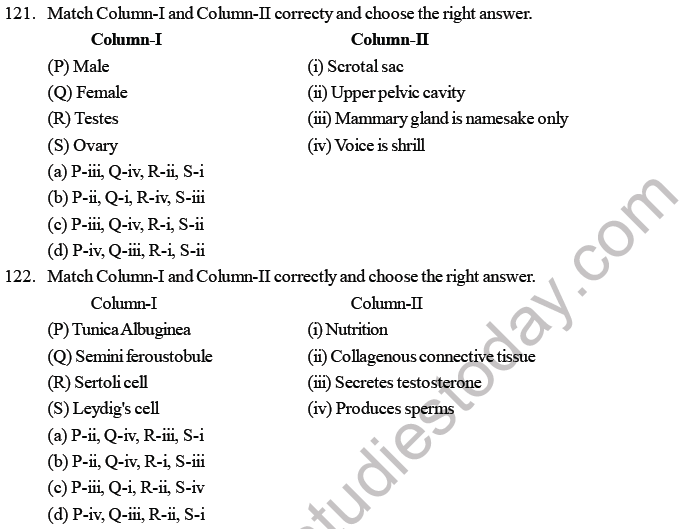
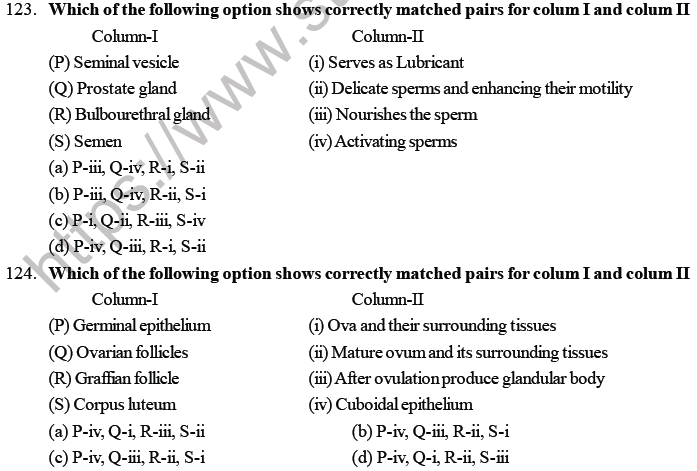
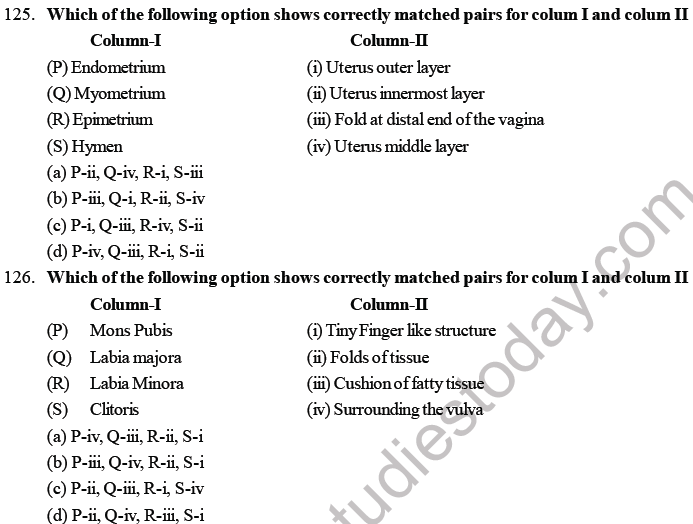
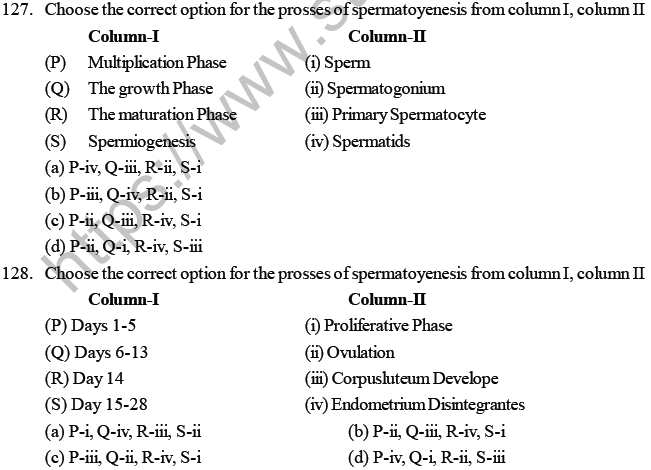
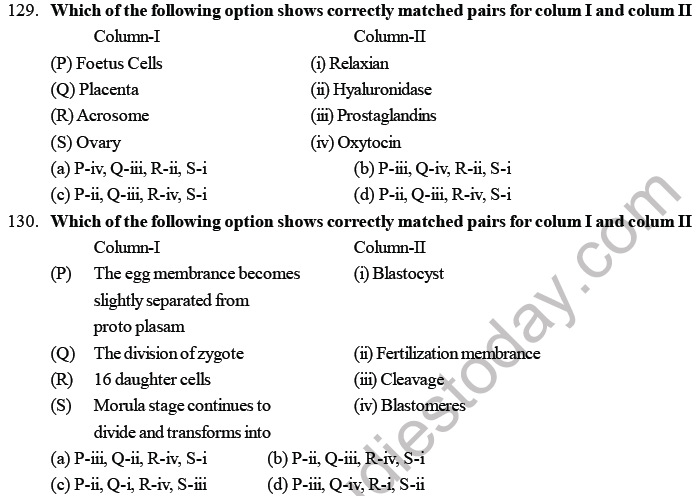
Note :- Q No. 131 to 145 Read the assertion and the reason carefully to mark the corrct option out of the options given.
(a) Assertion are true and the reason is a correct explanation of the assertion.
(b) Assertion are true and the reason is not a correct explanation of the assertion.
(c) The assertion is true but the reason is false.
(d) The assertion is false but the reason is true.
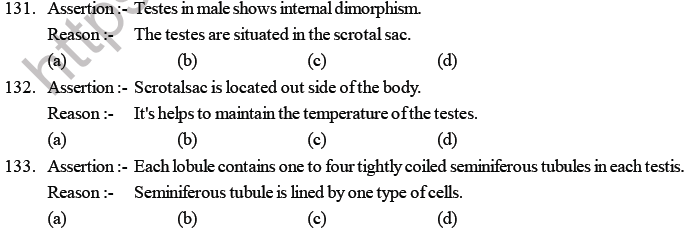

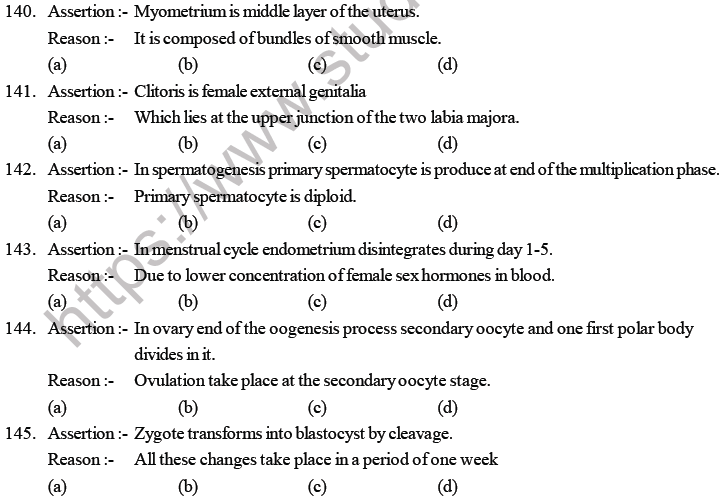
146. Which is incorrect for sexual dimorphism of male ?
(a) Mammary gland is namesake only
(b) Voice is shrill
(c) Muscle are strong
(d) Beard and mustache develops
147. Which pair is not correct ?
(a) teste - scrotalsac
(b) ovary - upper pelvic cavity
(c) vas deferens - ejaculatory duct
(d) Fallopion tube - Ovulation
148. Which option shows correct chronology of cell production during spermatogenesis ?
(a) Germinal epithelium --> Spermatogonium --> Primary Spermatocyte --> Secondary Spermatocyte -->Spermatids.
(b) Germinal epithelium --> Spermatids --> Spermatogonium --> Primary Spermatocyte --> Secondary Spermatocyte
(c) Germinal epithelium --> Primary Spermatocyte --> Secondary Spermatocyte--> Spermatogonium --> Spermatids.
(d) Germinal epithelium --> Primary Spermatocyte --> Spermatogonium--> Secondary Spermatocyte--> Spermatids.
149. Which option is incorrect for the centriole function in spermiogenesis ?
(a) The two centrioles of the spermatids
(b) The antrior one is known as proximal centriole
(c) One is known as distal centriole
(d) The distal centriole changes into the tail.
150. The correct order of the changes in hormones level at first day to 28th day of menstrual cycle.
(a) estrogen and progesterone level is lower --> Estrogen rising --> Progesterone rising.
(b) estrogen and progesterone level is higher --> Estrogen lower --> Progesterone rising.
(c) estrogen and progesterone level is lower --> Estrogen rising --> Progesterone lower.
(d) estrogen and progesterone level is higher --> Estrogen rising --> Progesterone rising.
* Identyfy the parts from given diagrame (151 to 155)
151. Identify the part-a
(a) Spermatid
(b) Secondary spermatocyte
(c) Primary Spermatocyte
(d) Sertoli cell
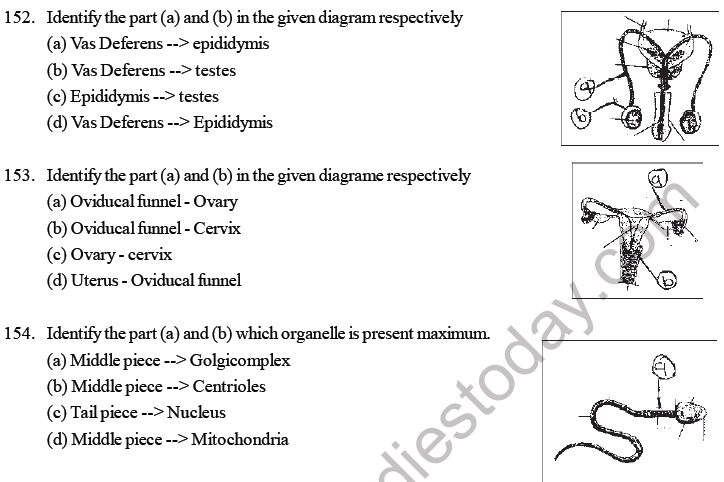

156. In human the unpaired male reproductive structure is_____
(a) Seminal vesicle
(b) Prostate
(c) Bulbourethral gland
(d) Testes
157. Which of the follwing is an accessory reproductive gland in male mammals.
(a) Prostate gland
(b) Gastric gland
(c) Mushroom shaped gland
(d) Inguinal gland
158. The semini ferous tubules of the testies are lined bye the germinal epithelium consisting___
(a) Cells of sertoli
(b) Spermatocytes
(c) Spermatogonium
(d) Spermatids
159. Sperms cells are produced in
(a) Semini ferous tubules
(b) Interstitial space
(c) Epididymis
(d) Prostate gland
160. In the absence of acrosome the sperm _______.
(a) Cannot penetrate the egg
(b) Cannot get energy
(c) Cannot get food
(d) Cannot swim
161. If after ovulation no pregnancy result the corpus luteum
(a) Is maintained by the presence of progesterone
(b) Degenerates in a short time
(c) Becomes active and secretes lot of FSH and LH
(d) Produces lot of oxytocin and relaxin
162. How many secondary spermatocyte will be required to form 400 spermatozoans.
(a) 100
(b) 200
(c) 40
(d) 400
163. 1st polar body is formed at which stage of oogenisis
(a) 1st Meiosis
(b) 2nd Mitosis
(b) 1st Mitosis
(d) Differentiation
164. In oogenesis diploid cell produce _______ ovum.
(a) 1
(b) 2
(c) 3
(d) 4
165. The process of delivery of the foetus is called
(a) Parturition
(b) Implantation
(c) Fertilisation
(d) Lactation

